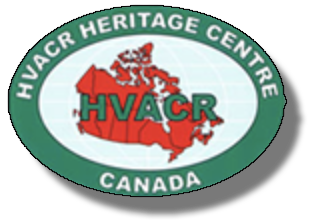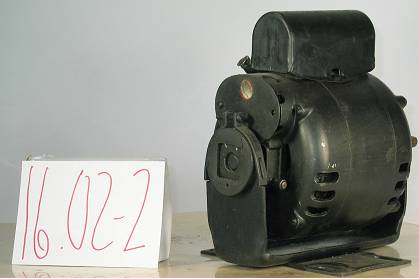Electric Motors – Single Phase Capacitor Start and Capacitor Run Motors
A mid 20th century, high tech, 25cycle capacitor-start motor, a new generation of high starting torque refrigeration motors made possible by the electrolytic, chemical capacitor, equipped with advanced, inherent, heat overload protection, with automatic reset and designed for “V” belt drive applications, with light alloy end bells, vibration isolating, rubber, torsion motor mount on slotted base for belt tightening, Delco, Circa 1948. [see also 12.02-2B]
Features:
Built for 25 cycle, 110 volt alternating current, representative of motor design used in Ontario prior to frequency standardization in the late 1940’s
Oringinal T.H. Oliver shop tag, in Howard Oliver’s writing
Technical Significance:
Built for 25 cycle, 110 volt alternating current, this motor is a now rare example, representative of motor design used in Ontario prior to frequency standardization in the late 1940’s
A truly advanced piece of FHP induction motor technology, built for the then rapidly expanding refrigeration equipment market, equipped with advanced engineering features new for the period, including:
Vibration isolating, rubber, torsion motor mounts; Drive bearing extended, safety oilier; Electrolytic, chemical capacitor technology; high tech inherent, overload, thermal protection with automatic reset; light weight alloy end bells, taking advantage of new high tech metallurgy
The motor exemplifies the latest in automatic over load protection, an on-going challenge through the early years in the development of unitary, fully automated refrigeration equipment, designed to operate safely, un-attended in the home.
This generation of FHP capacitor-start motor technology in many ways would stand as a consummate achievement, a kind of icon of “the art form”, made economically possible by the high market demand for FHP motors in the Post W.W.II period. It was a market, too, that was augmented by the prospects of frequency standardization, and the massive undertaking of replacing all 25 cycle motors with 60 cycle equipment.
The motor stands as a marker of the golden age in the post W.W.II expansion of the refrigeration industry in Canada, a period which saw the development of the commercial refrigeration market, based on open system refrigeration technology serving food stores, confectioneries, institutions and the like with fractional horsepower belt driven equipment, demonstrating remarkable versatility and inventiveness. It would be the last great period of expansion prior to the rush to re-equip the market with a new generation of hermetic [sealed] motor/compressors. Here the motor and compressor would both disappear from, sight both sealed in a single enclosure. The refrigeration motor, and the technology that made it possible, as it appears here, would disappear forever.
Industrial Significance:
The development and commercial production of the capacitor-start single phase FHP motor, starting in the mid 1940’s was a seminal event in the history of the HVACR field. The capacitor-start motor would come to replace the more costly and complex repulsion induction motor, RI [See Group 16.01], with one with fewer moving mechanical parts, quieter, more reliable and maintainable, typically at lower cost. By allowing for electrical switching between starting and running windings, it would facilitate external relay control, rather than internal mechanical mechanisms, as with the RI motor. It would therefore be amenable for use in hermetically sealed refrigeration systems.
Early experimentation, leading to the eventual commercial development of the FHP, capacitor start-motor, began with the work of Steinnmetz [American engineer and inventor 1865 – 1923], 40 years before. But commercial production had to await the development of practical capacitors of sufficient capacity, the chemical, electrolytic capacitor. Early, paper capacitors, large enough to provide the required phase shift for motor starting, where larger than the motor itself, and were subject to short operating life span [see Reference 3]
Conventional industrial practice for refrigeration systems, with compressors operating at conventional speeds, in the 1930’s through 60’s, saw these motors attached by “V” belt drive to the refrigeration compressor with a compressor fly wheel about three times that of the diameter of the motor pulley. [see reference #4]. Maintaining belt alignment and tension was a constant challenge, due to close coupling of motor and compressor for space saving.
The race to produce a quieter running, vibration free motor was on, a public expectation coming with the rapidly expanding post W.W.II market. Delco would be an acknowledged market leader in the development and production of the isolating torsion mount. Other mounting technologies were developed, but of less staying qualities, [See for example item 16.01-10 and 16.01-11].
The race was on, also, to produce an inherently safer motor, safe for the Canadian householder who was required to attend to routine maintenance tasks such as oiling. It was a period well in advance of sealed bearing technology with lifetime lubrication. Wick-oiled bronze bearings of the time required oiling quarterly. In belt driven refrigeration equipment this brought the householder in contact with a moving, compressor drive belt and whirring condenser fan blade. The design of the extended oilier tube would be a simple but significant safety feature, for householder and service man alike, allowing fingers to keep out of danger’s way.


